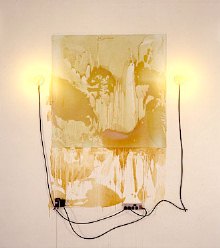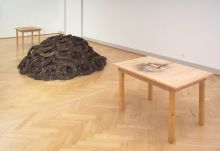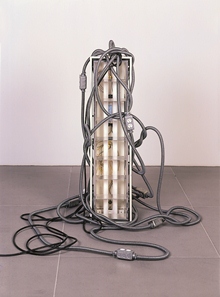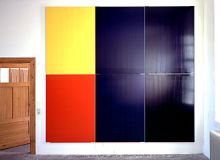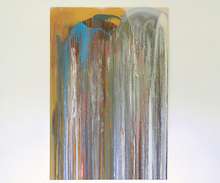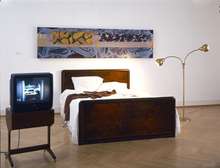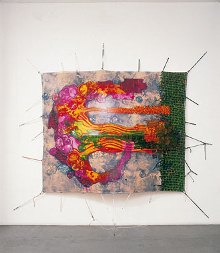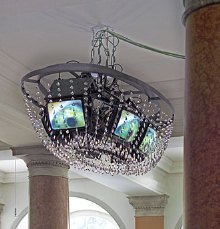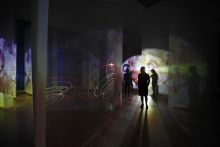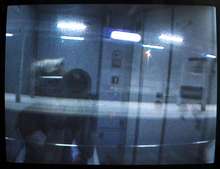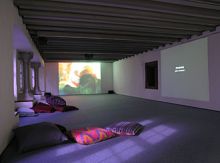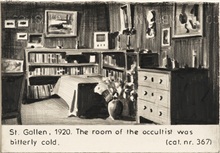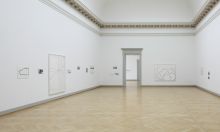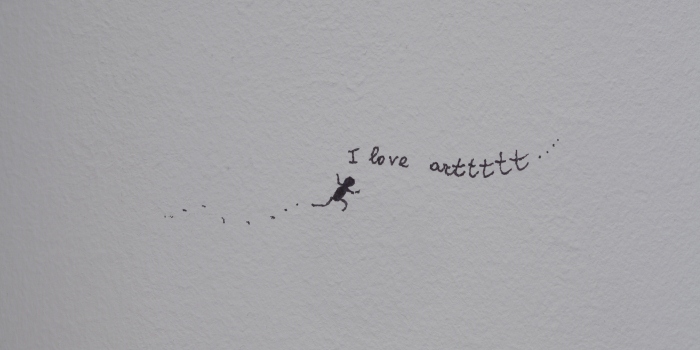
Contemporary positions
A differentiation of positions in terms of content has followed from the artistic achievements of the 1960s until the present day: not only are material are explored in sculpture, the material and appearance of color in painting, but also the possibilities of new media. In the St. Gallen collection, exemplary works represent different positions in contemporary art: Roman Signer (*1938), Keith Sonnier (*1941), Karin Sander (*1957), and Erwin Wurm (*1954) in sculpture, Lawrence Weiner (*1942) and On Kawara in the area of conceptual art, Markus Raetz (*1941), Ilona Ruegg (*1949), and Alex Hanimann (*1955) in drawing, Imi Knoebel (*1940), Olivier Mosset (*1940), and Jessica Stockholder (*1959) in the expanded field of painting, and Nam June Paik (*1932) and Pipilotti Rist (*1962) in the area of video art.
Expanded concept of sculpture
Keith Sonnier (*1941), along with Bruce Nauman (*1941), Richard Serra (*1939), Bill Bollinger (1939-1988), and Barry Le Va (*1941) is considered a pioneer of so-called post-minimal art. His early explorations of different materials, such as felt and latex, and their inherent material qualities led to the neon sculptures with which he gained international recognition beginning in 1968. These are captivating mainly through the attraction of the colored light; its «erotic» echoes are typical of Sonnier’s works.
«Tutto è connesso» (everything is connected), is the title of Mario Merz’s (1925–2003) impressive igloo, realized by the master of Italian Arte Povera in the foyer of the Kunstmuseum. The artist flashes back to the origins of humanity by referring to the archaic form of an igloo. In his endeavor to connect primordial history with the present, he makes use of novel materials, mainly, neon light. The series of numerals lighting up between the stone slabs– 1 (+) 1 (=) 2 (1+2=) 3 (2+3) 5 (3+5) 8, and so on—are based on the Italian mathematician Fibonacci and hint at a movement that accelerates from an initially slow advance through to the rapid tempo of the present day. The artist, who is represented in the collection with a first-class work group, contrasts the historical splendor of museum architecture with a «poor» materiality, which in its simple presence and archaic nature, thematizes fundamental social as well as existential issues.
The work of Roman Signer from eastern Switzerland is also fundamentally influenced by the process-oriented art of the late 1960s. The sculptor expands classical sculpture by adding the dimension of time, or rather, by making processes visible. His oeuvre is well documented in the Kunstmuseum St.Gallen, beginning from early works, such as Warschauer Projekt (1971), which is only available in the form of sketches and model photos, through to the well-known Aktion mit einer Zündschnur (1989), which enriches the collection as an extensive object. From September 11 to October 15, 1989, the artist had a fuse burn along the train track from the town where he was born, Appenzell, to his present home, St.Gallen. Not only were space and time covered by the work, but it can also be understood as cutting a path, in a concrete as well as metaphoric sense—embedded in a landscape that the beholder only conceptually deduces. By consistently following his artistic approach, transitory works arise that generally remain preserved only in videos, or in previously meticulously planned photo series documenting all work phases. This is shown exemplarily in Schwarzes Tuch (1994), Fahrrad mit Raketen (1995), and Kleine Ereignisse Hotel Castell, Zuoz (1996).
Active in the environment of an expanded concept of sculpture are also artists such as Erwin Wurm (*1954), Christoph Rütimann (*1955), Matthew McCaslin (*1957), Karin Sander (*1957), Sylvie Fleury (*1961), Christoph Büchel (*1966), Koenraad Dedobbeleer (*1975), and Nadim Vardag (*1980), who are represented in the collection with, in part, considerable work groups.
Painting of today
Contemporary painting is present in the collection with distinguished individual works and extensive work groups by Marcia Hafif (*1929), Imi Knoebel (*1940), Olivier Mosset (*1940), Gunter Umberg (*1942), Helmut Federle (*1944), Günther Förg (*1952), and Bernard Frize (*1955), while David Reed (*1946), John Armleder (*1948), Jessica Stockholder (*1959), and Fabian Marcaccio (*1963) open up the classical panel painting to other artistic genres and media.
In addition to Blinky Palermo, Imi Knoebel was one of Joseph Beuys’ most important students at the Düsseldorf Academy. Already during his education, he distinguished himself from his influential role model and discovered a style of painting in which the categorical conditions of the medium are constantly re-questioned. His oeuvre, which is of great importance for painting, can be presented in St. Gallen in a way that is not possible at any other Swiss museum thanks to a substantial bundle of Linienbildern (1966-1968), the Hartfaserkreuz (Fiberboard cross) (1968/86), and the intensely-colored painting on aluminum from the current work phase, Hello Darkness (2001).
As performer, painter, and installation artist, John Armleder is among the most important sources of inspiration for generations of contemporary artists who move at the interface between high and popular culture. His oeuvre is eminently represented in St. Gallen with Furniture Sculptures, and a painting from the Pour Painting series provides it with a topical highlight. Armleder hereby recycles art history, especially Morris Louis’s poured paintings. In addition, through the use of luminous signal colors and sparkling glimmer, he allows references to popular culture and the party and disco scene to resonate; thus combining the classical panel painting with the mundane surroundings of our lived environment.
«I have always aspired to be a bedroom painter,» emphasizes New York–based artist David Reed. His oeuvre, which begins in the 1970s with process-oriented paintings, is among the most fascinating in contemporary art. In Scottie’s Bedroom (1994), considered the artist’s main work, he integrates one of his own paintings into a bedroom ensemble and confronts it with a film sequence from Vertigo, Alfred Hitchcock’s famous film. In it, the same painting is, in turn, digitally inserted into a bedroom scene. With the cryptic concept, the artist refers to the mass media of film and in a passionate way, questions the possibilities of painting in an expanded field of contemporary visuality.
That applies also to the oeuvre of Fabian Marcaccio. In his painterly «collages,» the gestures of Abstract Expressionism combine with various technical reproduction techniques and the visual world of new media to highly complex painterly organisms, which he identifies as «paintant» as a blending of painting and mutant, whereby he attempts to situate painting in the present.
New media
In addition to photography, whose development since the 1970s is represented in the Kunstmuseum St. Gallen’s collection with work groups by Manon (*1946), Urs Lüthi (*1947), Hannah Villiger (1951-1997), and Beat Streuli (*1957), recent acquisitions have also been made in the new visual media of video. Its key positions are represented in the collection from the pioneer generation—Nam June Paik (*1932), Silvie and Chérif Defraoui (*1935 / 1932-1994)—through to the present, with works by renowned artists, including Pipilotti Rist (*1962), Teresa Hubbard / Alexander Birchler (*1965/*1962), and Shahryar Nashat (*1975).
The trained musician Nam June Paik, who emerged in the 1960s in Germany in the environment of the Fluxus movement and the Düsseldorf scene around Joseph Beuys, is generally considered the grandfather of video art. Thanks to a generous gift from Heinrich E. Schmid, the St. Gallen collection is able to make one of Paik’s important installations available to the public on a permanent basis. Beuys-Voice – A Hole in the Hat, which was created in 1987 for the documenta 8, is an artistic homage to his companion Joseph Beuys who had died the year before. Shown in staccato-like cuts are short successions of images from a shared performance, individual signs of the artist, such as the burning hat, cut against computer-generated sequences, which would prove exemplary, not only for the development of video art, but also for the subsequent MTV and music video generation.
St. Gallen artist Pipilotti Rist, whose oeuvre is meanwhile celebrated throughout the world, is among the younger generation of video artists. Her first museum exhibition was held at the Kunstmuseum St.Gallen, and the collection also houses numerous works by the artist. Early single-channel video works, as well as expansive installations. T.V.-Lüster (1993), permanently installed in the museum foyer, is a loan from the Swiss federal state. The unique video object comprises six monitors on which the artist’s eyes circle to the beat of a polka. The sophisticatedly arranged work combines two basic themes of video art—the surveillance camera, and the picture screen as a magical lamp—and in doing so, playfully exudes a feeling of happiness that will definitely stay with the visitor on their tour through the museum.
In 2012 it was possible to acquire a further key work from the artist’s oeuvre thanks to special means from the City and Canton of St. Gallen, as well as generous support from the Raiffeisen Jubiläumsstiftung and the Stiftung Ars Rhenia. As a spectacularly staged installation in the Oberlichtsaal, Administrating Eternity (2011) forms the climax of the retrospective exhibition of blood-driven cameras and overflowing spaces by Pipilotti Rist, which took place at the Kunstmuseum St. Gallen in 2012. In this masterpiece, central elements of her video work come together: the extensive staging is just as characteristic of her unmistakable artistic language as are dizzying camera spans and somersaulting images, which with technical distancing and associative montage flow into an infectious, colorful flow of images. The artist cleverly examines the supposed truth-content of the electronic medium and creates sensual pictorial spaces, within which visitors submerge to experience an amazing feeling of happiness. Rist expands the direct statement of earlier works in terms of content through the dream-like moment in Administrating Eternity. As the title indicates, administrating eternity seems to be a primordial human craving. The artist refers to the precarious state between waking and sleeping, which resonates in the accompanying sound.
Among the most recent generation of video artists is Candice Breitz (*1972) from South Africa, who has found major international recognition with exhibitions in recent years and is now represented in the St. Gallen collection with two impressive works, Becoming Julia, 2003, and Me Myself I, 2001. The latter is the title of a popular hit by American songwriter Joan Armatrading from the 1980s. The artist translates this in a video that combines a type of road movie with what is practically a private, insider view, while Becoming Julia deconstructs the role model permanently produced by the dream factory of Hollywood, and insistently poses the question of the construction of identity in today’s media age.
Wild Seeds is the title of an impressive video installation realized for the first time by Yael Bartana, born in 1970, at the Istanbul Biennale in 2005. In her oeuvre, the Israeli artist confronts us with mediatized experiences of reality. She has been occupied repeatedly with the militarization of everyday Israeli life, and the self-evidence of the Jewish state, and found images for them that have a deeply unsettling inherent quality, such as in the supposed children’s games in Wild Seeds.
Drawing
In addition to the field of contemporary sculpture, also the drawing collection has been given crucial impetus in recent years through significant gifts and acquisitions of contemporary art. For example, finding their way into the collection were distinguished and extensive drawing series by Silvia Bächli (*1956), Nedko Solakov (*1957), Marcel van Eeden (*1965), Ante Timmermans (*1976), and Marc Bauer (*1975), among others. An impressive installation with drawings by Franz Ackermann (*1963) is among the most recent acquisitions (see donations and new acquisitions).
A highlight among the current new acquisitions in the area of contemporary drawing is the multipart ensemble «das (to Inger Christensen),» (2008-09), which Silvia Bächli developed for the Swiss Pavilion at the 53rd Biennale di Venezia and perfectly adapted for her exhibition «far apart – close together» in the Oberlichtsaal of the Kunstmuseum St.Gallen.

